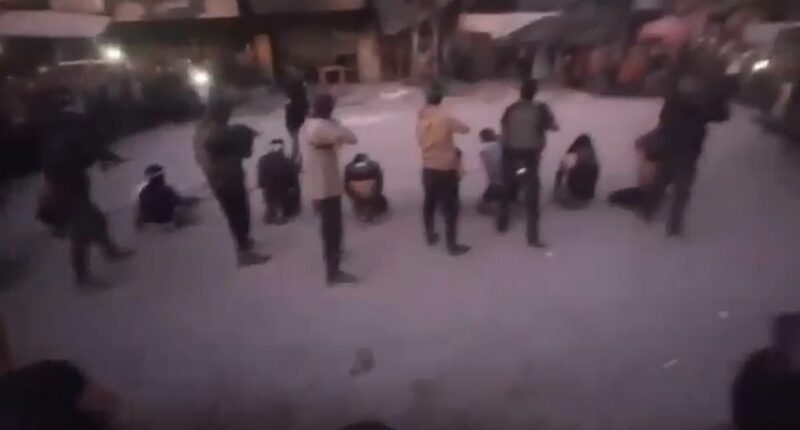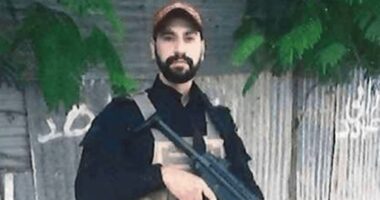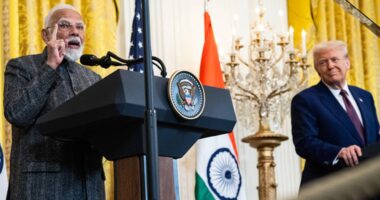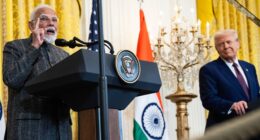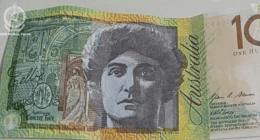Share this @internewscast.com
Few have endured the extreme ordeals faced by Moumen al-Natour, a Palestinian activist opposing Hamas’s rule over Gaza. His experiences under the Sunni Islamist group’s regime are harrowing and relentless.
From brutal lashings to being stripped and confined in a cramped cell for a full day, the 30-year-old lawyer has repeatedly suffered for his outspoken stance against the oppressive leadership.
As the mastermind behind the 2019 ‘We Want to Live’ protests against Hamas, Moumen constantly finds himself in jeopardy. His activism has led to imprisonment on 20 separate occasions, alongside numerous incidents of torture.
Hamas accuses him of collaborating with foreign entities like Israel and the Palestinian Authority, claiming he incites discord within the community—allegations he passionately refutes.
Moumen insists his actions are driven by a desire to improve life for his people in Gaza, where, he claims, most residents have grown weary of Hamas due to the ongoing conflict.
His experiences highlight the brutal tactics employed by the group to retain control over the besieged region.
Whether that’s starving the lawyer in prison, or threatening him with the rapes of his mother and sister, there is no limit to the brutality the group has been prepared to wield when it comes to suppressing dissent.
But no matter what kind of ISIS-inspired torture methods Hamas has used against him, Moumen will stop at nothing to secure the rights of the 2.2 million civilians in the territory – who he insists are ready for new leadership.

Moumen al-Natour is a Gazan lawyer and co-founder of the anti-Hamas protest movement ‘We Want to Live’

A horrifying video on social media appears to show Palestinians being executed by Hamas

In the video, a crowd can be seen cheering as the men are slaughtered. There are chants of ‘Allah Akbar,’ or God is Great. The men are also called ‘collaborators’
Life for Gazans throughout the war with Israel has been nothing short of a nightmare, with displacement, hunger and the threat of strikes defining everyday life.
But as well as the danger posed by aerial bombardment and Israeli gunfire, Palestinians have been oppressed by the very government that purports to fight in their name.
Founded in 1987, Hamas has been in control of the impoverished enclave for almost two decades, making dissent near-impossible for civilians who know that speaking out could cost them their life.
‘They have an art in torturing a person and inflicting severe harm without remorse,’ Moumen says in an exclusive interview with the Daily Mail.
‘In their view, they are right and anyone who opposes them is an infidel and can be killed by a fatwa of a cleric affiliated with Hamas.’
In summer, his home in the Strip’s capital was raided by militants in their latest attempt to hunt him down and punish him for his activism.
He is unable to disclose his current location for fear of putting himself and his family in danger, but gave a detailed account of the humiliating and sadistic rituals of torture Hamas has deployed against him over time.
On one occasion, militants beat him up and proceeded to suspend him by his legs upside down from a metal platform fixed to the prison wall known as a ‘Blanco’.
The interrogators then lowered him from the platform, forced him to strip, poured water over his head and lashed him with a whip.
Afterwards, Moumen was forced to hold a squat for up to 24 hours, causing excruciating pain.
Prison guards have used sinister methods to exhort information from Moumen, who described one occasion when a Hamas agent stormed into his cell and held a weapon to his head, demanding he ‘confess quickly’.
‘They insulted me with obscene language and threatened to bring my father, mother, brothers and sisters to the prison to torture them.
‘Once, someone even told me they could rape my mother and sisters in front of me.’
At other times, Moumen was sure he would die at the hands of Hamas, especially on one occasion after the mass ‘We Want to Live’ protests six years ago.
As punishment, he was blindfolded, led outside to a yard, and was told he would be executed immediately for ‘collaborating with Israel and working against Hamas’.
‘They fired a shot and the bullet passed beside me. I fell to the ground – I had been imagining, with the blindfold on, what would happen and how I would die unjustly at the hands of Hamas within a minute.
‘After hearing the shot I fell and lost consciousness. When I woke up from fainting, I found myself back in my cell.’
Over the past decade, Hamas has locked Moumen up in a series of jails, including the Ansar Central Prison and the Qasr al-Hakim Prison, but he says his activist collaborators have been detained in the basements of mosques.
‘Wherever Hamas exists, there is a prison,’ the lawyer says.
His guards would starve him, giving him only half of a ‘very small’ apple to eat per day. ‘I drank from the tap water in the cell’s bathroom. They treated me very cruelly,’ he says.
The cells were mostly in underground basements. Usually, he’d be in solitary confinement, but other times the guards would send someone in pretending to be an anti-Hamas activist who hated the terrorist group, in an attempt to get Moumen to confess.
In recent days, horrifying footage has emerged on social media which shows Palestinians being executed by Hamas, sparking fears that the peace deal brokered by U.S. President Donald Trump is already at risk of collapsing as the terror group tries to cling to power.
In one video, a group of seven men can be seen kneeling on the ground with their hands behind their backs, as armed militants – some wearing Hamas-style headbands – stand behind them.
Gunshots ring out before the kneeling group fall to the ground, apparently lifeless.

A girl holds a Palestinian flag in the central Gaza Strip after U.S. President Donald Trump announced that Israel and Hamas agreed on the first phase of a ceasefire

Palestinians celebrate following the announcement that Israel and Hamas have agreed to the first phase of a peace plan to pause the fighting, in Khan Younis, southern Gaza Strip, Thursday, October 9, 2025

Palestinians celebrate the announcement of a ceasefire agreement between Hamas and Israel in Khan Younis, southern Gaza Strip
On October 7, 2023, Hamas attacked southern Israel, killing 1,200 people and taking more than 250 others hostage. The massacre triggered a war that has seen over 67,000 Gazans killed, according to the Strip’s health ministry.
Not only that, but the enclave has been plunged into a humanitarian crisis, where at least 70 percent of infrastructure has been turned to rubble, civilians are dying of malnutrition and the sick lack access to essential medicine because of the near-collapse of the health system.
Instead of helping to keep civilians safe and fed, Moumen says Hamas has done the precise opposite: from looting aid and using civilians as human shields to keeping themselves secure in a 450-mile underground tunnel network while women and children die above ground.
Back in spring, thousands of Palestinians were filmed taking to the streets to protest against the terrorist group, in a reflection of the fact that ‘most of the population of the Gaza Strip hate Hamas and want rid of them,’ Moumen says.
‘Everyone is suffering. People have lost their homes, their money, everything. We’re seeing civilians leaving Gaza City without a place to stay, without money: from nothing to nothing.’
But the authoritarian government has cracked down on resistance, according to Moumen, who says schools have been turned into prisons where members of his protest movement are detained for daring to imagine an alternative to Hamas’ rule.
It’s not just anti-government activists who Hamas targets with prison sentences and physical punishments, but their families.
Moumen’s own brother was arrested in March 2019 as a way for militants to blackmail the lawyer into handing himself into authorities, after he was instrumental in that year’s economic protests against high tax and the rising cost of living.
‘I fled and went into hiding when I knew Hamas was coming, but then they arrested my brother and said if I don’t come, we’ll kill him,’ Moumen says.
‘They came right to my house and confiscated all the phones and communication devices of my family, so they couldn’t call me, and they told my parents that when more men surrender themselves, we will release your son.
‘My brother was tortured, physically and psychologically.’
According to Moumen, reporters used by media organisations based in the Strip such as Al Jazeera and Al-Aqsa TV are doing surveillance work for Hamas, helping the government crackdown on dissidence. Al Jazeera has denied the claims.
He says his social media accounts are surveyed by so-called reporters who report any suspicious activity to Hamas’ security agents.
Such media companies are part of the ‘propaganda machine’ that Hamas manipulates, Moumen says, as a way to suppress the population’s knowledge of their government-fuelled oppression.
‘They have the media, the government – they have everything in their hands,’ he says. ‘Al Jazeera is 100 percent taking the narrative of Hamas and inciting [hatred] against us.’
Even before the war begun and life in the enclave became intolerable, Moumen was outspoken about how conditions under Hamas were debilitating for the civilian population.

Palestinian members of the Ezzedine al-Qassam Brigades, the armed wing of the Hamas movement

Palestinians, including children, gathered in the city of Khan Yunis celebrate after the announcement of the ceasefire agreement in Gaza on October 9, 2025

Palestinians celebrate following the announcement outside Al-Aqsa Hospital in Deir al-Balah, central Gaza Strip
‘I was around 12-years-old when Hamas staged a coup and took over Gaza, so I was able to witness the changes.
‘Before, me and my family were able to buy food and other essentials without hardship. After Hamas took over, it became much harder.’
In 2007, the Islamist group ousted members of the rival Fatah party and conquered the Strip, implementing economic policies that Moumen describes as ‘miserable’, including high taxes to support the ‘so-called resistance’.
Opposition to the economic policies came to a head in 2019, when civilians took to the streets to demand change amid a 70 percent youth unemployment rate, high taxes on items such as cigarettes and the trebling in price of basic food items like fruit.
Even as the population was suffering, Hamas used money from tax revenues and foreign donors – including financial aid from Qatar – to build an elaborate network of tunnels in the enclave, diverting money that could have been spent on improving civilian life to building its war machine.
The tunnels, used as command bunkers and munitions depots, stretch between 350 and 450 miles in a territory that’s just 25 miles long. To put those figures in perspective, the London Underground is only 249 miles long.
While the underground network could have helped shield the population from aerial bombardment after October 7, 2023, the safety of the population wasn’t the terrorist group’s priority. ‘At the beginning of the war, Mousa Abu-Marzouk, a senior Hamas leader, said the tunnels are only for the resistance fighters, not for the civilians,’ Moumen says.
For Hamas, ‘the civilians are refugees, and it is the responsibility of the United Nations and UNRWA to protect them’.
Not only did Hamas fail to protect citizens from Israel’s aerial bombardment – the government also exasperated malnutrition across the Strip by stealing aid, Moumen says.
In August, the Integrated Food Security Phase Classification (IPC) said more than half a million people across Gaza are facing ‘catastrophic’ conditions characterised by ‘starvation, destitution and death’ amid Israel’s ‘man-made’ famine.
Israel fiercely denies such claims and disputes the presence of starvation in the Strip, but has consistently accused Hamas of stealing aid at the border.
Moumen alleges that militants loot supplies from aid convoys at the Kerem Shalom border and either resell produce on the black market for inflated prices or gift supplies to loyalists, depriving the population of essentials.
In response to the humanitarian crisis bracing the Strip, the lawyer founded the Palestinian Youth for Development, to help deliver aid to the worst hit areas and also to provide teaching to children who have dropped out of school amid the war.
Repairing and rebuilding education in the enclave will be one of the biggest battles when Gaza eventually begins to rebuild.
Some 90 percent of schools and university buildings have been destroyed across the Strip due to Israeli strikes, according to the UN, but even before that, children rarely received an education free from propaganda, according to Moumen.
He has made it his mission to teach Gaza’s youth the values of ‘equality, tolerance and peace’, to counter Hamas’ curriculum of ‘hatred and violence’.
In classes before the war struck, it was commonplace for children to be taught that killing the Jews was a ‘divine duty’ among Muslims, necessary to liberate Palestine and bring them to heaven, according to the activist.
Minors would be enrolled in munitions classes where they were taught to use weapons. Meanwhile, military-style haircuts were brutally encouraged – meaning young boys who liked to have their hair like footballer Cristiano Ronaldo would be beaten up as punishment for not conforming.
The vast majority of the civilian population in Gaza has had enough of Hamas, Moumen says, but they’re afraid to ‘speak up’ for fear of deadly punishments.
If it goes to plan, Trump’s 20-point peace deal could finally spell an end to Hamas’ oppressive rule, and trigger the first steps towards a peaceful, democratic, and independent Palestinian state.
But such a future relies on leaders being willing to disarm and step down so a new government can lead Gaza.
Only time will tell whether the militants will accept the offer of amnesty, or try and continue their reign of terror in the region.
